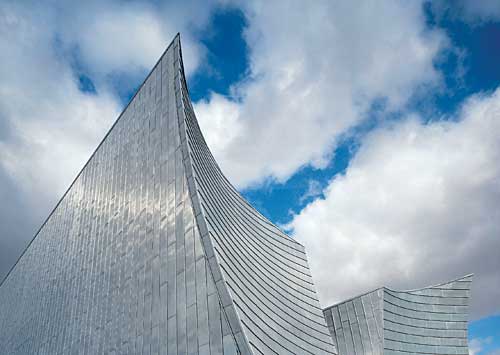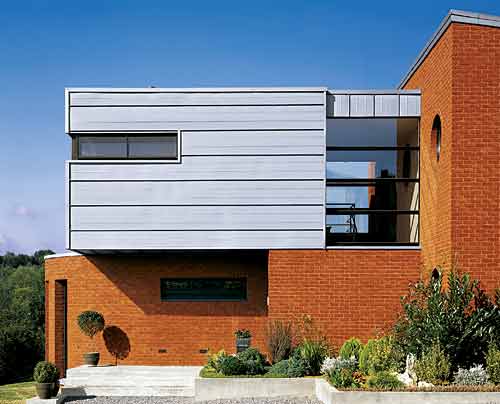Architectural Zinc: From Gray to Green
Time-tested Durability
Two distinct but closely related attributes of zinc in buildings are major factors in its overall environmental performance: its durability and recyclability. This durability is not theoretical. Long before the advanced alloys of today (and before anyone suspected that the environment was not eternal), especially in the unforgiving climates of northern Europe, zinc roofs were prized for their longevity, resistance to corrosion, low maintenance, relative light weight and the workability that lent itself to traditional craftsmanship at a very high level. The widespread application of zinc in roofing and wall cladding began in the 19th century (although there are earlier buildings still extant). Often these were civic buildings and cathedrals, built to last for generations, if not forever. Some of these roofs are still in service. The tradition continues to be strong in Europe, where zinc is a much more widely used building material than in this country.
|
Today, zinc products used in architecture for roofs and walls have an extremely long service life: an estimated 80 to100 years for roofs, and 200 to 300 years for walls, depending on the exact product, geographic location and local conditions, including the amount of air pollution.
Durability is a key component of sustainability. The National Institute of Standards and Technology defines Life Cycle Cost as the total discounted dollar cost of owning, operating, maintaining and disposing of a building or building system over a period of time. The service life over which zinc materials are evaluated is much longer than with almost any other building material.
Durability is not only a matter of simple longevity, but also of the costs necessary in maintaining a material throughout its life, and those involved in disposing of it at the end (or, ideally, at the beginning of its use in yet another product). To take roofs as an example, in a 2004 study conducted by Ducker International, owners and property managers reported performing little or no maintenance on their metal roofs (the study included all types of metal roofs, not just zinc). A comparison of maintenance costs over the life of the roof for metal versus asphalt and single-ply showed that owners of metal roofs spent approximately 3 percent of total installed costs on maintenance, versus 28 percent for asphalt and 10 percent for single-ply.
|
For most conventional roofing materials, their removal, disposal and replacement, on average every 17 years but in many cases more often, also represents a major environmental factor. The need for multiple roofs over a building's lifetime makes roofing materials a large contributor to the waste stream. For example, it is estimated that at l east 9 to 10 million tons of asphalt roofing materials from tear-offs and installation scraps ends up in landfills every year. A 2007 Army Corps of Engineers technical bulletin cites an estimate that 7 to 10 percent of the nation's landfill space has gone to roofing waste over the last 40 years. An asphalt shingle will take some 300 years to decompose.
When costs are extended over multiple generations, the sustainability of building components with very long service lives-even those with relatively higher costs at some points in their life cycle-may be better, and their overall environmental impact lower, than that of alternatives with much shorter service lives and problematic maintenance, repair and replacement profiles.
Zinc material requires little maintenance over its service life; its patina constantly renews itself as it weathers and ages and will "heal over" scratches and imperfections, requiring no touch-up or repainting. Because the metal is uncoated, there is no possibility of the fading, chipping or peeling that otherwise needs recurrent attention. A single zinc roof, with a lifespan of 80 to 100 years may well outlast the building it has been sheltering. And if or when zinc material is removed, it will never see a landfill.











